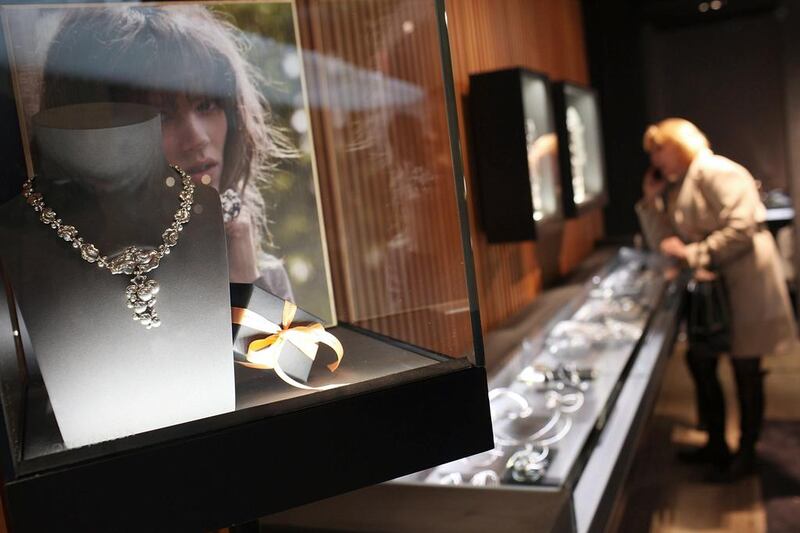In the jewellery industry in the United States, not all that glitters is gold.
While demand for the precious metal is surging, consumers are also eyeing diamonds, ranging from classic styles to modern blue stones, and personalised jewellery made of silver, gold or platinum.
A variety of promising factors are bedazzling the industry, signalling that the sector is well on its way to a recovery after being hit by the recession.
In fact, jewellery sales are expected to grow 9 per cent overall this year, according to a recent retail forecast from IBM Global Business Services.
It also helps that consumer confidence has reached a six-year high this year, according to The Conference Board.
Industry trade shows are benefiting from renewed interest among attendees. In May, the premiere jewellery industry convention JCK Las Vegas boasted show traffic that was up 5 per cent, and the high-end trade show Luxury reported a 9 per cent surge in traffic. The September Hong Kong Jewellery & Gem Fair reportedly had the best show since the recession.
According to the market researcher LGI Network, the luxury jewellery market, in particular, is making a comeback.
Overall, the branded jewellery market is up 3 per cent year-to-date. The most popular price points are items costing $1,500 to $3,000, which make up 23 per cent of the industry and are up 6 per cent compared with the same period last year.
“We’ve seen an increase in customer spending over the past year. However, in recent months, we’ve had a notable increase in sales of more expensive pieces and diamond jewellery,” says Carrie Jester, the owner of Jester Jewelers in Cincinnati, Ohio.
Diamond pieces, ranging from traditional styles to modern blue diamonds, are among the luxury jewellery items catching the eyes of consumers.
According to the consulting firm Bain & Company’s latest report on the diamond industry, the market will remain balanced over the next four years through 2017. Starting in 2018, however, the gap between supply and demand is expected to widen as existing mines are depleted and no major new deposits come online.
Over the next 10 years, supply and demand are expected to grow at a compound annual rate of 2 per cent and 5.1 per cent, respectively.
Despite strong growth in China and India in recent years, the US remains the world’s largest market for diamond jewellery by a “comfortable margin”, according to Bain & Co’s report.
Demand for gold jewellery is also on the rise. According to the World Gold Council’s (WGC) gold demand trends report, which examined the supply and demand during the second quarter ofthis year, demand for was up 37 per cent at 575 tonnes, compared with 421 tonnes in the second quarter of last year.
Despite the price of gold falling by more than $400 an ounce, a 12 per cent drop, the WGC said the demand for gold jewellery was so strong that it outweighed the decline. Demand for gold in terms of value rose 20 per cent to nearly $26.2 billion.
China and India represented the biggest markets for gold jewellery, where demand was up 54 per cent and 51 per cent, respectively, year-over-year.
“Although jewellery demand is influenced by a wide set of factors, including economic growth, consumer sentiment and disposable income, to name a few, all were eclipsed by the effect of the drop in the gold price,” the WGC reported. “The resultant buying frenzy caused a huge rise in regional premiums on gold, as supply chain bottlenecks caused delays in meeting demand.”
Demand included an increase in higher-carat gold jewellery, according to the WGC.
Personalised jewellery is also gaining momentum. Unity Marketing’s Luxury Tracking survey, which examines the top jewellery brands among consumers, revealed that Pandora, a Danish company specialising in customisable charm bracelets, rings, earrings and necklaces, emerged as the second-ranked luxury jewellery brand, following the traditional jeweller Tiffany.
“The key to Pandora’s success is that although the retailer falls in the luxury category, individual charms for the bracelets are very affordable on a per item basis, ranging from $25 to $50 per charm. However, the bracelet once it’s all decked out with charms and completed, ends up costing anywhere from $300 to $500,” said Pam Danziger, the president of Unity Marketing and author of Putting the Luxe Back in Luxury.
Another trend in the personalised jewellery segment includes monogramed pendants, a fashion that has recently garnered a following because of celebrities such as the country singer Taylor Swift and the television personality Lauren Conrad were spotted wearing them in public.
The trend has storeowners such as Mrs Jester going to great lengths to meet demand. She recently purchased new software that will allow her staff to design, customise and fabricate personalised jewellery pieces onsite in store.
“Personalised jewellery is not new in jewellery, but with so many celebrities wearing this, it has become more popular,” says Mrs Jester.
business@thenational.ae





